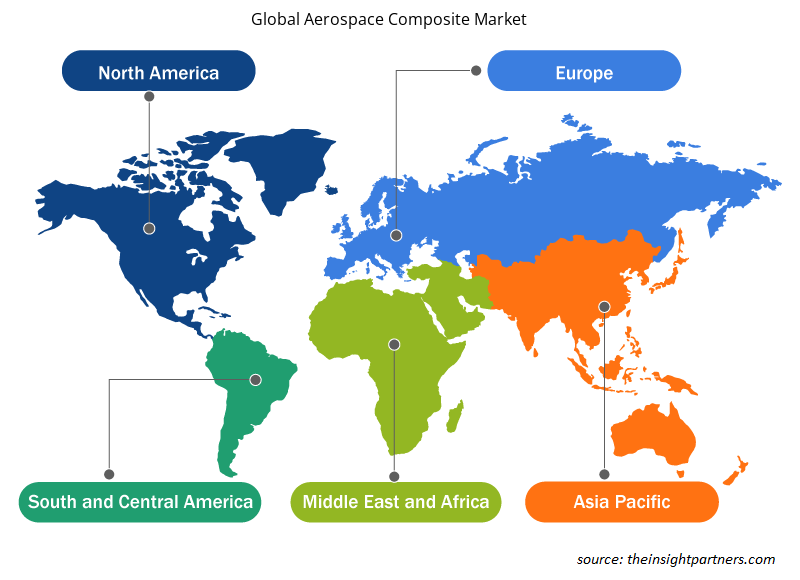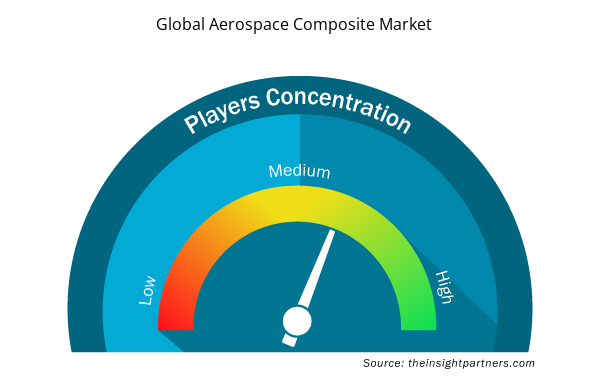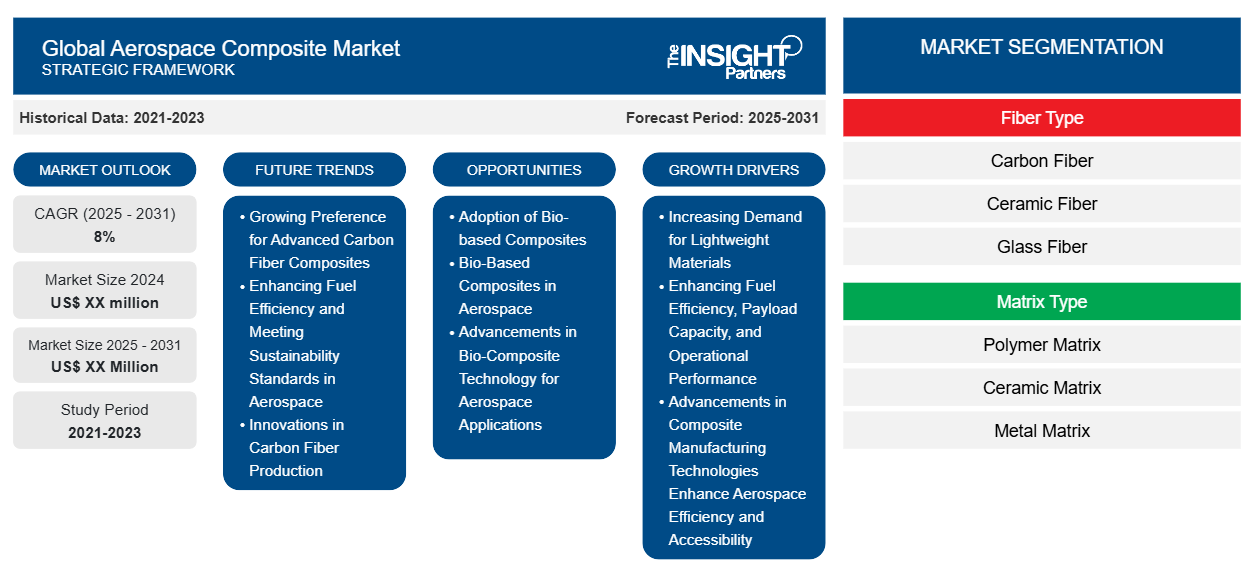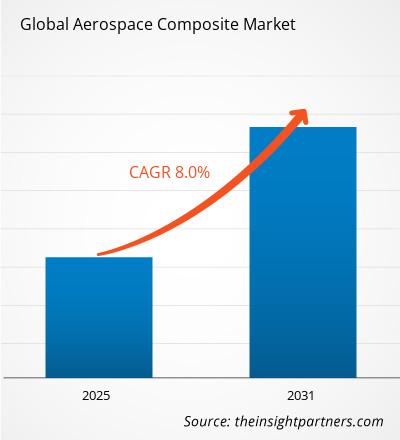Si prevede che il mercato dei compositi aerospaziali registrerà un CAGR dell'8% dal 2023 al 2031, con una dimensione di mercato in espansione da XX milioni di dollari nel 2023 a XX milioni di dollari entro il 2031.
Il report è segmentato per tipo di fibra (fibra di carbonio, fibra ceramica, fibra di vetro e altre). Il report presenta inoltre un'analisi basata sul tipo di matrice (matrice polimerica, matrice ceramica e matrice metallica). In base alla tecnologia, il report è segmentato in (Lay-Up, Resin Transfer Molding, Filament Winding e altre). In base all'applicazione, il report è segmentato in (interno ed esterno). L'analisi globale è ulteriormente suddivisa a livello regionale e nei principali paesi. Il report offre il valore in USD per l'analisi e i segmenti di cui sopra.
Scopo del rapporto
Il report Aerospace Composite Market di The Insight Partners mira a descrivere il panorama attuale e la crescita futura, i principali fattori trainanti, le sfide e le opportunità. Ciò fornirà spunti a vari stakeholder aziendali, come:
- Fornitori/produttori di tecnologia: per comprendere le dinamiche di mercato in evoluzione e conoscere le potenziali opportunità di crescita, consentendo loro di prendere decisioni strategiche informate.
- Investitori: condurre un'analisi completa delle tendenze in merito al tasso di crescita del mercato, alle proiezioni finanziarie del mercato e alle opportunità esistenti lungo la catena del valore.
- Enti di regolamentazione: regolamentano le politiche e le attività di controllo sul mercato allo scopo di ridurre al minimo gli abusi, preservare la fiducia degli investitori e sostenere l'integrità e la stabilità del mercato.
Segmentazione del mercato dei compositi aerospaziali
Tipo di fibra
- Fibra di carbonio
- Fibra ceramica
- Fibra di vetro
Tipo di matrice
- Matrice polimerica
- Matrice Ceramica
- Matrice metallica
Tecnologia
- Lay-Up
- Stampaggio a trasferimento di resina
- Avvolgimento del filamento
Geografia
- America del Nord
- Europa
- Asia-Pacifico
- America del Sud e Centro
- Medio Oriente e Africa
Geografia
- America del Nord
- Europa
- Asia-Pacifico
- America del Sud e Centro
- Medio Oriente e Africa
Personalizza questo report in base alle tue esigenze
Riceverai la personalizzazione gratuita di qualsiasi report, comprese parti di questo report, o analisi a livello nazionale, pacchetto dati Excel, oltre a usufruire di grandi offerte e sconti per start-up e università
- Scopri le principali tendenze di mercato in questo rapporto.Questo campione GRATUITO includerà analisi di dati che spaziano dalle tendenze di mercato alle stime e alle previsioni.
Fattori trainanti della crescita del mercato dei compositi aerospaziali
- Domanda crescente di materiali leggeri: la crescita complessiva del mercato dei compositi aerospaziali è notevolmente favorita da una domanda crescente di materiali leggeri. Con la domanda crescente di efficienza nei consumi e di minori emissioni, l'industria aerospaziale sta cercando aggressivamente di perdere qualche chilo. I compositi leggeri sono stati la soluzione ideale a questa esigenza nell'industria aerospaziale grazie ai loro eccellenti rapporti resistenza/peso. Ciò consente ai produttori di aeromobili di mantenere prestazioni ottimali riducendo al contempo i costi operativi.
- Miglioramento dell'efficienza del carburante, della capacità di carico utile e delle prestazioni operative: oltre a una migliore efficienza del carburante, i compositi leggeri aumentano la capacità di carico utile. La possibilità di ridurre il peso complessivo di un aereo significa trasportare merci aggiuntive o, in alcuni casi, più passeggeri, un importante fattore di miglioramento dei profitti. La direzione verso un'efficienza operativa sempre maggiore sta costringendo le aziende aerospaziali a investire in materiali compositi avanzati, prima di tutto, nei nuovi progetti di aeromobili, ma anche nel retrofit dei loro progetti esistenti.
- I progressi nelle tecnologie di produzione dei compositi migliorano l'efficienza e l'accessibilità aerospaziale: i progressi nelle tecnologie di produzione dei compositi stanno anche rendendo possibile la produzione di materiali leggeri. Altre innovazioni che vanno di pari passo con i processi automatizzati di posizionamento delle fibre e di infusione di resina hanno migliorato non solo l'efficienza ma anche la qualità dei componenti compositi. Ciò rende ulteriormente i compositi accessibili ai produttori in molte applicazioni aerospaziali.
Tendenze future del mercato dei compositi aerospaziali
- Crescente preferenza per i compositi avanzati in fibra di carbonio: la tendenza dei materiali emergenti in fibra di carbonio di nuova generazione sta guadagnando una posizione più dominante nel mercato dei compositi aerospaziali. Migliori dei predecessori, questi nuovi materiali possiedono maggiore resistenza, durata e attributi eccellenti per resistere a temperature estreme, qualità di prova adatte ad applicazioni di alto livello nel settore aeronautico. I compositi in fibra di carbonio si insinuano lentamente nelle prestazioni degli aeromobili con i produttori che spingono per ogni possibile miglioramento.
- Migliorare l'efficienza del carburante e soddisfare gli standard di sostenibilità nell'industria aerospaziale: le fibre di carbonio di nuova generazione sono molto leggere ma più resistenti e resistenti della generazione precedente e offrono un'efficienza del carburante significativamente più elevata con meno emissioni. Ciò è piuttosto cruciale poiché l'industria aerospaziale ora si rende conto che le tendenze verso la sostenibilità e la conformità con l'ambiente comportano normative molto più severe in materia di aviazione più ecologica. Gli aeromobili ad alte prestazioni possono, quindi, essere sviluppati incorporando fibre avanzate nella progettazione per soddisfare le normative sulle emissioni.
- Innovazioni nella produzione di fibre di carbonio: inoltre, c'è una crescente domanda di mercato dovuta alle innovazioni nei metodi di produzione delle fibre di carbonio. Il miglioramento nei processi di produzione, come la produzione continua di fibre, aumenta la coerenza e la qualità del materiale in fibra di carbonio. I miglioramenti attraverso questi sviluppi consentono ai produttori aerospaziali di adattare le fibre di carbonio a componenti complessi. Di conseguenza, aumenta l'applicazione delle fibre di carbonio nel settore.
Opportunità di mercato dei compositi aerospaziali
- Adozione di compositi a base biologica: i compositi a base biologica stanno diventando sempre più opportunità di crescita per il mercato dei compositi aerospaziali. Le crescenti preoccupazioni ambientali stanno attualmente spingendo le aziende aerospaziali a cercare materiali sostenibili per ridurre l'impronta di carbonio nel settore. Ecocompatibili, grazie alla loro origine da risorse rinnovabili, i compositi a base biologica sono ovviamente molto più sostenibili dei prodotti a base di petrolio che costituiscono la base di questo prodotto convenzionale.
- Compositi a base biologica nell'industria aerospaziale: questi compositi possiedono buone proprietà; sono costituiti da un elevato rapporto resistenza/peso e da prestazioni meccaniche migliorate. La natura leggera aumenta l'efficienza del carburante negli aerei; quindi, presi in considerazione da un produttore che si sforza di essere efficiente nel suo funzionamento e sostenibile per vedere la legge ambientale. La loro necessità di prestazioni sostenibili si traduce nell'adozione di questi compositi a base biologica.
- Progressi nella tecnologia dei biocompositi per applicazioni aerospaziali: ulteriori sviluppi nella tecnologia dei biocompositi aumentano le loro applicazioni aerospaziali. Ulteriori sviluppi nella nuova formulazione della resina e nelle tecniche di rinforzo possono migliorare la loro durata e stabilità termica. Una ricerca migliorata fa progredire la possibilità di compositi a base biologica per parti aerospaziali critiche, aumentando ulteriormente la domanda nel mercato.
Approfondimenti regionali sul mercato globale dei compositi aerospaziali
Le tendenze regionali e i fattori che influenzano il Global Aerospace Composite Market durante il periodo di previsione sono stati ampiamente spiegati dagli analisti di Insight Partners. Questa sezione discute anche i segmenti e la geografia del Global Aerospace Composite Market in Nord America, Europa, Asia Pacifico, Medio Oriente e Africa e Sud e Centro America.

- Ottieni i dati specifici regionali per il mercato globale dei compositi aerospaziali
Ambito del rapporto sul mercato globale dei compositi aerospaziali
| Attributo del report | Dettagli |
|---|---|
| Dimensioni del mercato nel 2023 | XX milioni di dollari USA |
| Dimensioni del mercato entro il 2031 | XX milioni di dollari USA |
| CAGR globale (2023-2031) | 8% |
| Dati storici | 2021-2022 |
| Periodo di previsione | 2024-2031 |
| Segmenti coperti | Per tipo di fibra
|
| Regioni e Paesi coperti | America del Nord
|
| Leader di mercato e profili aziendali chiave |
|
Densità dei player del mercato globale dei compositi aerospaziali: comprendere il suo impatto sulle dinamiche aziendali
Il mercato globale dei compositi aerospaziali sta crescendo rapidamente, spinto dalla crescente domanda degli utenti finali dovuta a fattori quali l'evoluzione delle preferenze dei consumatori, i progressi tecnologici e una maggiore consapevolezza dei vantaggi del prodotto. Con l'aumento della domanda, le aziende stanno ampliando le loro offerte, innovando per soddisfare le esigenze dei consumatori e capitalizzando sulle tendenze emergenti, il che alimenta ulteriormente la crescita del mercato.
La densità degli operatori di mercato si riferisce alla distribuzione di aziende o società che operano in un particolare mercato o settore. Indica quanti concorrenti (operatori di mercato) sono presenti in un dato spazio di mercato in relazione alle sue dimensioni o al valore di mercato totale.
Le principali aziende che operano nel mercato globale dei compositi aerospaziali sono:
- Elettrico generale
- Società Hexcel
- Società Materion
- Mitsubishi Rayon Co. Ltd
- Società di materiali rinnegati
Disclaimer : le aziende elencate sopra non sono classificate secondo un ordine particolare.

- Ottieni una panoramica dei principali attori del mercato globale dei compositi aerospaziali
Punti di forza chiave
- Copertura completa: il rapporto affronta in modo completo l'analisi di prodotti, servizi, tipologie e utenti finali del mercato dei materiali compositi aerospaziali, fornendo una panoramica olistica.
- Analisi degli esperti: il rapporto è compilato sulla base della conoscenza approfondita di esperti e analisti del settore.
- Informazioni aggiornate: il rapporto garantisce la pertinenza aziendale grazie alla copertura di informazioni recenti e tendenze nei dati.
- Opzioni di personalizzazione: questo report può essere personalizzato per soddisfare le esigenze specifiche del cliente e adattarsi in modo appropriato alle strategie aziendali.
Il rapporto di ricerca sul mercato dei compositi aerospaziali può quindi aiutare a guidare il percorso di decodificazione e comprensione dello scenario del settore e delle prospettive di crescita. Sebbene possano esserci alcune preoccupazioni valide, i vantaggi complessivi di questo rapporto tendono a superare gli svantaggi.
- Analisi storica (2 anni), anno base, previsione (7 anni) con CAGR
- Analisi PEST e SWOT
- Valore/volume delle dimensioni del mercato - Globale, regionale, nazionale
- Industria e panorama competitivo
- Set di dati Excel



Report Coverage
Revenue forecast, Company Analysis, Industry landscape, Growth factors, and Trends

Segment Covered
This text is related
to segments covered.

Regional Scope
North America, Europe, Asia Pacific, Middle East & Africa, South & Central America

Country Scope
This text is related
to country scope.
Domande frequenti
Growing Preference for Advanced carbon fiber composites is expected to be the key market trends.
Based on geography, Asia Pacific held the largest share of the aerospace composite market.
Based on fiber type, glass fiber, is expected to witness the fastest growth during the forecast period
General Electric, Hexcel Corporation, Materion Corporation are some of the key players operating in the aerospace composite market
Increasing Demand for Lightweight Materials is driving the market growth
The Aerospace Composite Market is estimated to witness a CAGR of 8% from 2023 to 2031
Trends and growth analysis reports related to Chemicals and Materials : READ MORE..
The List of Companies
1. General Electric
2. Hexcel Corporation
3. Materion Corporation
4. Mitsubishi Rayon Co. Ltd
5. Renegade Materials Corporation
6. Royal Ten Cate
7. SGL Group
8. Solvay Group
9. Teijin Ltd.
10. Toray Industries Ltd.
The Insight Partners performs research in 4 major stages: Data Collection & Secondary Research, Primary Research, Data Analysis and Data Triangulation & Final Review.
- Data Collection and Secondary Research:
As a market research and consulting firm operating from a decade, we have published and advised several client across the globe. First step for any study will start with an assessment of currently available data and insights from existing reports. Further, historical and current market information is collected from Investor Presentations, Annual Reports, SEC Filings, etc., and other information related to company’s performance and market positioning are gathered from Paid Databases (Factiva, Hoovers, and Reuters) and various other publications available in public domain.
Several associations trade associates, technical forums, institutes, societies and organization are accessed to gain technical as well as market related insights through their publications such as research papers, blogs and press releases related to the studies are referred to get cues about the market. Further, white papers, journals, magazines, and other news articles published in last 3 years are scrutinized and analyzed to understand the current market trends.
- Primary Research:
The primarily interview analysis comprise of data obtained from industry participants interview and answers to survey questions gathered by in-house primary team.
For primary research, interviews are conducted with industry experts/CEOs/Marketing Managers/VPs/Subject Matter Experts from both demand and supply side to get a 360-degree view of the market. The primary team conducts several interviews based on the complexity of the markets to understand the various market trends and dynamics which makes research more credible and precise.
A typical research interview fulfils the following functions:
- Provides first-hand information on the market size, market trends, growth trends, competitive landscape, and outlook
- Validates and strengthens in-house secondary research findings
- Develops the analysis team’s expertise and market understanding
Primary research involves email interactions and telephone interviews for each market, category, segment, and sub-segment across geographies. The participants who typically take part in such a process include, but are not limited to:
- Industry participants: VPs, business development managers, market intelligence managers and national sales managers
- Outside experts: Valuation experts, research analysts and key opinion leaders specializing in the electronics and semiconductor industry.
Below is the breakup of our primary respondents by company, designation, and region:

Once we receive the confirmation from primary research sources or primary respondents, we finalize the base year market estimation and forecast the data as per the macroeconomic and microeconomic factors assessed during data collection.
- Data Analysis:
Once data is validated through both secondary as well as primary respondents, we finalize the market estimations by hypothesis formulation and factor analysis at regional and country level.
- Macro-Economic Factor Analysis:
We analyse macroeconomic indicators such the gross domestic product (GDP), increase in the demand for goods and services across industries, technological advancement, regional economic growth, governmental policies, the influence of COVID-19, PEST analysis, and other aspects. This analysis aids in setting benchmarks for various nations/regions and approximating market splits. Additionally, the general trend of the aforementioned components aid in determining the market's development possibilities.
- Country Level Data:
Various factors that are especially aligned to the country are taken into account to determine the market size for a certain area and country, including the presence of vendors, such as headquarters and offices, the country's GDP, demand patterns, and industry growth. To comprehend the market dynamics for the nation, a number of growth variables, inhibitors, application areas, and current market trends are researched. The aforementioned elements aid in determining the country's overall market's growth potential.
- Company Profile:
The “Table of Contents” is formulated by listing and analyzing more than 25 - 30 companies operating in the market ecosystem across geographies. However, we profile only 10 companies as a standard practice in our syndicate reports. These 10 companies comprise leading, emerging, and regional players. Nonetheless, our analysis is not restricted to the 10 listed companies, we also analyze other companies present in the market to develop a holistic view and understand the prevailing trends. The “Company Profiles” section in the report covers key facts, business description, products & services, financial information, SWOT analysis, and key developments. The financial information presented is extracted from the annual reports and official documents of the publicly listed companies. Upon collecting the information for the sections of respective companies, we verify them via various primary sources and then compile the data in respective company profiles. The company level information helps us in deriving the base number as well as in forecasting the market size.
- Developing Base Number:
Aggregation of sales statistics (2020-2022) and macro-economic factor, and other secondary and primary research insights are utilized to arrive at base number and related market shares for 2022. The data gaps are identified in this step and relevant market data is analyzed, collected from paid primary interviews or databases. On finalizing the base year market size, forecasts are developed on the basis of macro-economic, industry and market growth factors and company level analysis.
- Data Triangulation and Final Review:
The market findings and base year market size calculations are validated from supply as well as demand side. Demand side validations are based on macro-economic factor analysis and benchmarks for respective regions and countries. In case of supply side validations, revenues of major companies are estimated (in case not available) based on industry benchmark, approximate number of employees, product portfolio, and primary interviews revenues are gathered. Further revenue from target product/service segment is assessed to avoid overshooting of market statistics. In case of heavy deviations between supply and demand side values, all thes steps are repeated to achieve synchronization.
We follow an iterative model, wherein we share our research findings with Subject Matter Experts (SME’s) and Key Opinion Leaders (KOLs) until consensus view of the market is not formulated – this model negates any drastic deviation in the opinions of experts. Only validated and universally acceptable research findings are quoted in our reports.
We have important check points that we use to validate our research findings – which we call – data triangulation, where we validate the information, we generate from secondary sources with primary interviews and then we re-validate with our internal data bases and Subject matter experts. This comprehensive model enables us to deliver high quality, reliable data in shortest possible time.


 Ottieni un campione gratuito per questo repot
Ottieni un campione gratuito per questo repot